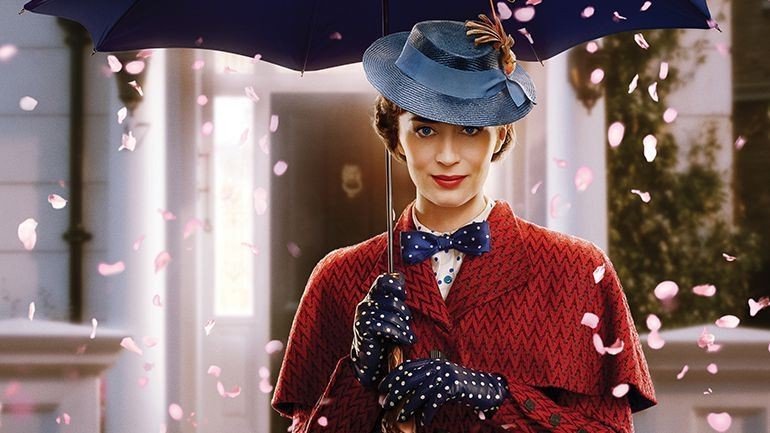
When the original Mary Poppins film graced the silver screen in 1964, it captivated audiences with its enchanting blend of live-action and hand-drawn animation, as well as the iconic performance of Julie Andrews in the titular role. The story of a magical nanny who descends from the skies to transform the lives of the Banks family struck a chord with generations of viewers, becoming a beloved classic that has endured for over half a century.
Now, over 50 years later, the world has been gifted with a long-awaited sequel, Mary Poppins Returns, directed by Rob Marshall and starring the talented Emily Blunt as the enigmatic nanny. As a content creator, I was eager to revisit the world of Mary Poppins and see how this new chapter would unfold. After watching the film, I can confidently say that the magic of the original has been beautifully recaptured, with a delightful blend of nostalgia and fresh storytelling that is sure to captivate audiences both young and old.
Honoring the Legacy: Seamless Transition and Familiar Faces
One of the most impressive aspects of Mary Poppins Returns is the way it seamlessly transitions from the original film while introducing new characters and storylines. The sequel picks up several decades after the events of the first movie, with the Banks children, Michael and Jane, now grown up and facing their own challenges.
Michael, played by the talented Ben Whishaw, is a recent widower struggling to raise his three young children in the very same house on Cherry Tree Lane. Facing financial troubles and the looming threat of losing his home, Michael finds himself in desperate need of the magical touch that only Mary Poppins can provide. Enter Emily Blunt, who steps into the iconic role with grace and charm, effortlessly capturing the essence of the beloved nanny while infusing the character with her own unique interpretation.
Alongside Blunt, the film features a delightful ensemble of familiar and new faces. Lin-Manuel Miranda shines as the charming lamplighter, Jack, who serves as a guide and companion to the Banks children, while Emily Mortimer and Julie Walters bring their own comedic flair as the eccentric housekeeper, Ellen, and the kindly neighbor, Mrs. Brill, respectively.
The inclusion of Dick Van Dyke, who portrayed the lovable chimney sweep, Bert, in the original film, is a particularly heartwarming touch. His brief but memorable appearance serves as a nod to the past, seamlessly connecting the two eras and reminding audiences of the enduring legacy of Mary Poppins.
Visually Stunning: Capturing the Magic of the Original
One of the hallmarks of the original Mary Poppins film was its stunning visual effects, which seamlessly blended live-action with hand-drawn animation. In Mary Poppins Returns, the filmmakers have once again managed to create a visually captivating experience that pays homage to the past while embracing modern techniques.
The musical numbers, choreographed by the acclaimed director of Chicago, Rob Marshall, are a true delight to behold. From the energetic Trip a Little Light Fantastic to the whimsical A Cover Is Not the Book, the dance sequences are a feast for the senses, showcasing the incredible talent of the cast and the meticulous attention to detail in the production.
The film’s use of practical effects, such as the integration of live-action and animated elements, is particularly impressive. The sequence where Mary Poppins and the children venture into a magical porcelain bowl is a standout, seamlessly blending the real and the fantastical in a way that is both visually stunning and true to the spirit of the original.
Additionally, the film’s production design, costumes, and overall aesthetic capture the timeless charm of 1930s London, transporting the audience to a world of wonder and enchantment. The attention to detail is truly remarkable, with every frame evoking a sense of nostalgia and wonder that is sure to delight both longtime fans and newcomers to the world of Mary Poppins.
Emotional Resonance: Exploring Themes of Loss, Grief, and Rediscovering Joy
While Mary Poppins Returns is undoubtedly a delightful and whimsical film, it also explores deeper themes that add emotional depth to the story. The central narrative revolves around the Banks family’s struggle to cope with the recent loss of Michael’s wife, which has left him and his children in a state of grief and uncertainty.
The film’s exploration of loss and the importance of family is particularly poignant, as Mary Poppins’ arrival not only helps the Banks children rediscover their sense of wonder and joy but also serves as a catalyst for Michael to confront his own grief and find a path forward.
The relationship between Michael and his children, as well as the bond between the siblings, Jane and Michael, is beautifully portrayed, with the actors delivering nuanced and heartfelt performances that tug at the heartstrings. The film’s ability to balance the whimsical and the emotional is a testament to the skilled storytelling and the filmmakers’ understanding of the enduring appeal of the Mary Poppins franchise.
Musical Delight: Catchy Tunes and Memorable Performances
No Mary Poppins film would be complete without its iconic musical numbers, and Mary Poppins Returns delivers an impressive array of catchy tunes and memorable performances. Composer Marc Shaiman and lyricist Scott Wittman have crafted a score that seamlessly blends the classic sound of the original with fresh, modern sensibilities.
The film’s standout musical moments include:
Trip a Little Light Fantastic – A high-energy, tap-dancing extravaganza that showcases the incredible talents of Lin-Manuel Miranda and the ensemble cast.
A Cover Is Not the Book – A playful and imaginative number that highlights Emily Blunt’s vocal prowess and her ability to effortlessly navigate the film’s whimsical tone.
The Place Where Lost Things Go – A poignant and emotional ballad that explores the themes of grief and loss, delivered with heartbreaking sincerity by Emily Blunt.
Nowhere to Go But Up – A rousing and uplifting finale that brings the film to a joyful and satisfying conclusion, leaving the audience with a renewed sense of hope and wonder.
The musical numbers not only serve as delightful entertainment but also seamlessly advance the plot and deepen the emotional connections between the characters. The cast’s vocal performances are consistently impressive, with Emily Blunt and Lin-Manuel Miranda standing out as particular highlights.
For fans of the original film, the inclusion of classic songs like A Spoonful of Sugar and Supercalifragilisticexpialidocious will be a welcome treat, providing a sense of nostalgia and familiarity that enhances the overall viewing experience.
Appealing to a New Generation: Balancing Tradition and Innovation
One of the key challenges in creating a sequel to a beloved classic like Mary Poppins is striking the right balance between honoring the original and introducing new elements that will captivate a modern audience. Mary Poppins Returns navigates this delicate balance with remarkable skill, delivering a film that feels both familiar and fresh.
The filmmakers have taken great care to preserve the essence of the original, from the whimsical tone and the magical realism to the endearing characters and the timeless themes of family, wonder, and self-discovery. At the same time, they have infused the story with a contemporary sensibility, updating the visual style, the musical numbers, and the narrative to appeal to a new generation of viewers.
The inclusion of modern elements, such as the use of computer-generated imagery and the incorporation of more diverse representation, ensures that Mary Poppins Returns feels relevant and accessible to a wider audience. However, these updates are seamlessly woven into the fabric of the story, never feeling like a forced attempt to pander to a younger demographic.
The film’s ability to strike this balance is a testament to the skill and vision of the filmmakers, who have managed to create a sequel that honors the legacy of the original while introducing new and exciting elements that will captivate both longtime fans and newcomers to the world of Mary Poppins.
Conclusion: A Delightful and Enchanting Sequel
In the end, Mary Poppins Returns is a delightful and enchanting sequel that captures the essence of the beloved original while introducing a new chapter in the lives of the Banks family. With its stunning visuals, captivating musical numbers, and emotionally resonant storytelling, the film is a true delight for audiences of all ages.



